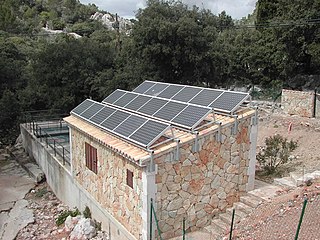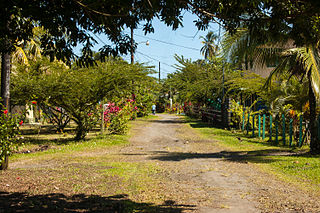
An eco-industrial park (EIP) is an industrial park in which businesses cooperate with each other and with the local community in an attempt to reduce waste and pollution, efficiently share resources, and help achieve sustainable development, with the intention of increasing economic gains and improving environmental quality. An EIP may also be planned, designed, and built in such a way that it makes it easier for businesses to co-operate, and that results in a more financially sound, environmentally friendly project for the developer.

Environment friendly processes, or environmental-friendly processes, are sustainability and marketing terms referring to goods and services, laws, guidelines and policies that claim reduced, minimal, or no harm upon ecosystems or the environment.

Green building refers to both a structure and the application of processes that are environmentally responsible and resource-efficient throughout a building's life-cycle: from planning to design, construction, operation, maintenance, renovation, and demolition. This requires close cooperation of the contractor, the architects, the engineers, and the client at all project stages. The Green Building practice expands and complements the classical building design concerns of economy, utility, durability, and comfort. Green building also refers to saving resources to the maximum extent, including energy saving, land saving, water saving, material saving, etc., during the whole life cycle of the building, protecting the environment and reducing pollution, providing people with healthy, comfortable and efficient use of space, and being in harmony with nature. Buildings that live in harmony; green building technology focuses on low consumption, high efficiency, economy, environmental protection, integration and optimization.’

CERES Community Environment Park is a 4.5-hectare (11-acre) not-for-profit environmental education centre and social enterprise hub located in urban Brunswick East, Victoria, Australia.

A Zero-Energy Building (ZEB), also known as a Net Zero-Energy (NZE) building, is a building with net zero energy consumption, meaning the total amount of energy used by the building on an annual basis is equal to the amount of renewable energy created on the site or in other definitions by renewable energy sources offsite, using technology such as heat pumps, high efficiency windows and insulation, and solar panels.

A sustainable city, eco-city, or green city is a city designed with consideration for social, economic, environmental impact, and resilient habitat for existing populations, without compromising the ability of future generations to experience the same. The UN Sustainable Development Goal 11 defines sustainable cities as those that are dedicated to achieving green sustainability, social sustainability and economic sustainability. They are committed to doing so by enabling opportunities for all through a design focused on inclusivity as well as maintaining a sustainable economic growth. The focus will also includes minimizing required inputs of energy, water, and food, and drastically reducing waste, output of heat, air pollution – CO2, methane, and water pollution. Richard Register, a visual artist, first coined the term ecocity in his 1987 book Ecocity Berkeley: Building Cities for a Healthy Future, where he offers innovative city planning solutions that would work anywhere. Other leading figures who envisioned sustainable cities are architect Paul F Downton, who later founded the company Ecopolis Pty Ltd, as well as authors Timothy Beatley and Steffen Lehmann, who have written extensively on the subject. The field of industrial ecology is sometimes used in planning these cities.
Green Star is a voluntary sustainability rating system for buildings in Australia. It was launched in 2003 by the Green Building Council of Australia (GBCA).

Council House 2 (also known as CH2), is an office building located at 240 Little Collins Street in the Melbourne central business district, Australia. It is used by the City of Melbourne council, and in April 2005, became the first purpose-built office building in Australia to achieve a maximum Six Green Star rating, certified by the Green Building Council of Australia. CH2 officially opened in August 2006.
This page is an index of sustainability articles.

The Bowden development is an urban development in the Australian state of South Australia on a site formerly owned by the Clipsal corporation in the suburb of Bowden, within the City of Charles Sturt, in the Adelaide metropolitan area 2 kilometres from the city centre.
The Conservation Council of South Australia, also known as Conservation SA and Conservation Council SA, is an environmental organisation serving as a peak body, representing over 50 member groups, representing over 90,000 individual members, in the state of South Australia.

Green buildings in Australia are assessed and rated by a variety of government and independent ratings systems.
Canada has implemented the "R-2000" in 1982 to promote better than building code construction to increase energy efficiency and promote sustainability. An optional feature of the R-2000 home program is the EnerGuide rating service. This service is available across Canada, allows home builders and home buyers to measure and rate the performance of their homes, and confirm that those specifications have been met. Some Canadian provinces are considering mandatory use of the service for all new homes.
A green building is one that uses less water, optimizes energy efficiency, conserves natural resources, generates less waste and provides healthier spaces for occupants, as compared to a conventional building. The Indian green building council (IGBC) is the leading green building movement in the country. Throughout the building lifecycle, green buildings employ practices that are resource- and environmentally-conscious. The idea of "green buildings" attempts to completely reduce any bad effects while maximizing any beneficial effects a structure has on both its surrounding environment and its human occupants.
Environmentally sustainable design is the philosophy of designing physical objects, the built environment, and services to comply with the principles of ecological sustainability and also aimed at improving the health and comfort of occupants in a building. Sustainable design seeks to reduce negative impacts on the environment, the health and well-being of building occupants, thereby improving building performance. The basic objectives of sustainability are to reduce the consumption of non-renewable resources, minimize waste, and create healthy, productive environments.

Green urbanism has been defined as the practice of creating communities beneficial to humans and the environment. According to Timothy Beatley, it is an attempt to shape more sustainable places, communities and lifestyles, and consume less of the world's resources. Urban areas are able to lay the groundwork of how environmentally integrated and sustainable city planning can both provide and improve environmental benefits on the local, national, and international levels. Green urbanism is interdisciplinary, combining the collaboration of landscape architects, engineers, urban planners, ecologists, transport planners, physicists, psychologists, sociologists, economists and other specialists in addition to architects and urban designers.
Bangladesh is one of the most vulnerable nations in the world due to climate change. As the ninth most populous country and twelfth most densely populated countries in the world, its rising population and limited land space have put tremendous strains on the urban ecosystem. The capital of Dhaka itself underwent severe transformations in recent years to catch up the increased rate of urbanisation. This change was paralleled by a boom in the real estate, construction and housing industry. According to United Nations Population Fund (UNFPA), Dhaka is one of the most polluted cities in the world.

Christie Walk is a model ecological cohousing development in central Adelaide, Australia. It consists of 27 dwellings on a 2,000 square metres site. It was designed by local architect Paul Downton and completed in 2006. Its innovative aspects include energy- and water-saving measures, use of ethical finance and use of recycled non-toxic materials.
‘Net positive’, from Positive Development (PD) theory, is a paradigm in sustainable development and design. PD theory was first detailed in Positive Development (2008). A net positive system/structure would ‘give back to nature and society more than it takes’ over its life cycle. In contrast, sustainable development - in the real-world context of population growth, biodiversity loss, cumulative pollution, wealth disparities and social inequities - closes off future options. To reverse direction, development must, among other sustainability criteria, increase nature beyond pre-human conditions. PD develops the tools to enable net positive design and development.












